The
Universal Monsters
|
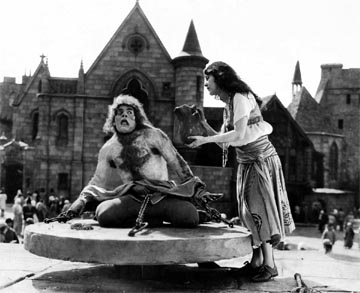
Lon
Chaney played the first of Universal's monsters in the
1925 Hunchback of Notre Dame.
|
The
year was 1923 and the film was The Hunchback of Notre Dame.
The movie, based on the classic book by Victor Hugo, was made
by a studio named Universal and would be the first of a series
of films that for more than the next three decades would, in
equal measure, horrify and delight filmgoers.
Universal
Studios was founded in 1912 with Carl Laemmle as its president.
Laemmle had entered the film business as the owner of a Nickelodeon
movie theater (the term Nickelodeon came from the entry fee
of 5 cents) but became tired of having to pay for expensive
films licensed through Thomas Edison's Motion Picture Trust.
Instead, in 1909, Laemmle and several other investors started
the Yankee Film Company. Yankee was one of the first studios
to give billing and screen credits to film actors and this idea
of highlighting the stars of the pictures soon became a standard
way to attract audiences into the cinema.
Though
Universal was founded on the east coast in New York a few years
later, it soon followed other motion picture companies to sunny
southern California and built a studio in 1915. Universal's
production facility soon became the largest in the world, though
the pictures it produced were generally considered to be not
very prestigious. Laemmle was a cautious studio chief and didn't
like to take on debt, which forced the studio to film on a shoestring
budget.
The
Hunchback of Notre Dame
|
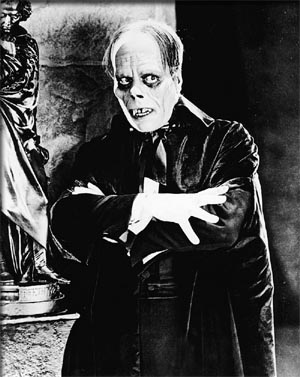
Chaney
as the Phantom.
|
Universal's
first brush with monsters came in 1922. By then Lon Chaney was
a well-known actor having had starring roles in The Miracle
Man in 1919 and The Penalty in 1920. Known as the
"Man of a Thousand Faces" for his ability to change his appearance
with makeup, he obtained the film rights to the Hunchback story
with the intention of playing the sympathetic monster, Quasimodo,
himself. After negotiating with several studios to produce the
picture, Chaney came to an agreement with Universal Studios
after studio manager Irving Thalberg assured Chaney that he
could convince Laemmle that Hunchback required a much significantly
bigger budget than the standard Universal film.
Thalberg
kept his promise and Hunchback had the largest budget
of any Universal picture to that date. It required extensive
sets to reproduce the Notre Dame cathedral and the surrounding
streets of 15th century Paris. In addition, some scenes required
hundreds of costumed extras. The production was so large that
at times director Wallace Worsley was forced to trade in his
megaphone for a radio and loudspeaker to direct the large crowd.
The
film was an unqualified success, grossing over $3 million. It
set the standard for future horror films and set a course forward
for Universal into the monster movie business.
Phantom
of the Opera
|
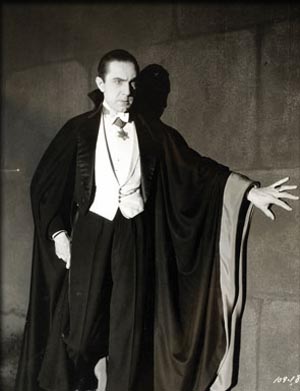
Bela
Lugosi starred as the Count on the stage before doing
it on the screen.
|
The
next major monster production for Universal also starred Lon
Chaney, this time as the disfigured, murderous, musical genius
of Gaston Leroux's 1910 novel, The Phantom of the Opera.
Laemmle had met Leroux on a trip to Paris and bought the rights
to the film as a vehicle for Chaney. The production, which included
reproduction of the interior of the Paris Opera house on Universal's
sound stage 28, went through several directors and aborted releases
until it premiered on October 17, 1925. Despite it being reviewed
as "only pretty good" by Time Magazine, the picture was
a success, bringing in $2 million. It was re-released in 1930
as a "talkie" after sound was added to a number of scenes, though
Chaney was unable to reprise his role to do his own voice as
he was under contract to another studio by then.
Dracula
The
next horror film released by Universal was Dracula, based
on the 1897 book by Bram Stoker and a 1924 stage play by Hamilton
Deane and John L. Balderston. Ironically, Carl Laemmle was not
really a fan of horror films, but after the triumph of Hunchback
and Phantom, it was difficult for him to argue with success,
His son, Carl Laemmle, Jr., was able to convince him to move
forward with the vampire picture. The elder Laemmle was also
not a fan of Bela Lugosi who had played the Count in the stage
play. Despite this Lugosi mangaged to get the part by ardently
campaigning for it, and lowering his pay to just $500 a week
which finally convinced the studio executives to hire him.
|
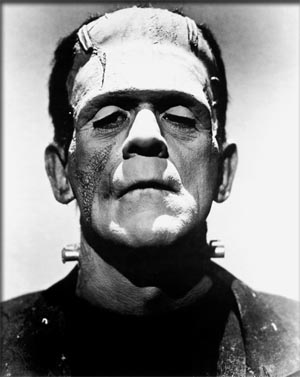
Frankenstein:
When Lugosi turned down the part, Karloff took it.
|
Despite
the earlier accomplishments of Hunchback and Phantom,
Universal was nervous about the success of Dracula. Neither
of the earlier features had supernatural components to the story.
How would American audiences react to an undead villain? The
executives need not have worried, however. When the film opened
at the Roxy in New York City on February 12, 1931, it sold 50,000
tickets within 48 hours and soon gave the studio a profit of
$700,000.
Frankenstein
Perhaps
the most famous and recognizable of all the Universal monsters
was a result of the 1931 film, Frankenstein, based on
the the 1818 Mary Shelly novel. While earlier makeup jobs for
Hunchback and Phantom had been done by the actor, Lon Chaney,
himself, Jack Pierce, with considerable input from the film's
director, James Whale, produced the horrifying and memorable
face of the mad scientist's creation. There are few people in
the world that do not immediately recognize the image of the
monster even if they have never seen the original film.
Coming
off his success as Count Dracula, Lugosi wanted the part of
the mad scientist. Laemmle, however, wanted him to play the
monster, a part, which as written at the time, was a boring
one-dimensional figure. Lugois, quoted as saying, "I was a star
in my country and I will not be a scarecrow over here!," left
the project and later Boris Karloff took the part. By then,
however, the script had been re-written to make the monster
a much more sympathetic and interesting character.
|
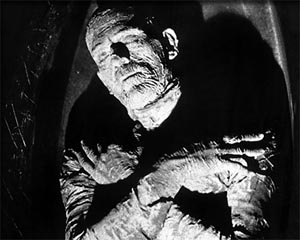
Boris
Karloff also played The Mummy in 1932.
|
Frankenstein
was a controversial picture running afoul of state censorship
boards in Massachusetts, Pennsylvania, Kansas, and New York
(particularly problematic was the declaration by the doctor
after his creature comes to life of "It's alive! It's alive!
In the name of God! Now I know what it feels like to be God!"
which was thought to be blasphemous). Despite this (or perhaps
because of it), the film was enormously successful, earning
a profit for the studio of over $700,000.
The
Mummy
Unlike
some of the other Universal monsters whose stories evolved out
of folklore and legend, 1932's The Mummy was inspired
by the opening of Tutankhamun's tomb a decade before. Laemmle,
Jr., commissioned John L. Balderston to write a script inspired
by Arthur Conan Doyle's short story entitled The Ring of
Thoth. Balderston set his tale in modern Egypt where a cursed,
mummified and undead, Egyptian priest (Boris Karloff) attempts
to bring his love back to life by sacrificing the film's heroine.
The production was popular and proved to be another financial
success for Universal.
The
Invisible Man
Whale,
the successful director of Frankenstein, went on to direct
1933's, The Invisible Man, based on H. G. Wells' science
fiction novel. Boris Karloff was supposed to do the part of
the scientist whose experiments with his own body make him disappear,
but contractual arguments made him leave the production, allowing
Whale to replace him with first choice, Claude Rains. It turned
out to be the studio's most successful picture since Frankenstein.
Bride
of Frankenstein
|
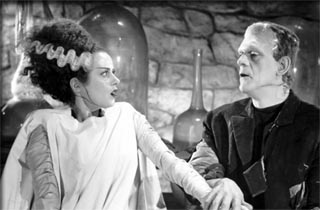
The
bride seems less than thrilled with her new boyfreind
in Bride of Frankenstein (1935).
|
While
many of the profitable Universal monster movies were given sequels,
Frankenstein's first one is of particular interest. With
the success of the original picture, Universal realized it needed
the director Whale to come back and do the follow up, too. Whale,
however, thought he'd done as much with the story as he could
and was uninterested in working on a sequel. He finally consented
after being given full control of the picture including the
script (along with a promise he could direct another film in
which he was interested: One More River). The result
was one of those rare things, a motion picture sequel which
is considered better than the original.
Karloff
repeated his role as the monster, while actress Elsa Lanchester
took the part of the creature's mate created by Frankenstein
in order to fulfill a promise to the monster. Lanchester also
played the writer, Mary Shelly, in a flashback at the beginning
of the picture.
Despite
the bride only appearing for a few minutes at the end of the
production, the makeup work of Jack Peirce again provided the
world with an indelible image of a literary character.
|
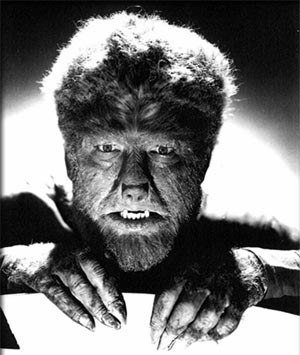
Lon
Chaney, Jr., starred as a werewolf in 1941's,The
Wolf Man.
|
The
Wolf Man
Nineteen-forty-one
saw Universal release the motion picture The Wolf Man. It
wasn't the first time Universal had attempted a movie based
on a werewolf legend. Nineteen-Thirty-Five's Werewolf of
London had not been a commercial success, however, and took
six years before the studio was willling go the lycanthropy
route again.
The
picture starred Lon Chaney, Jr., son of the actor in the
Hunchback and Phantom monster movies. Chaney played
Larry Talbot. Talbot, who returns to his ancestral home in Llanwelly,
Wales, is bitten by a werewolf and then struggles with his own
transformation into a version of the bloodthirsty creature.
Peirce's
make-up for Chaney was extensive and required five or six hours
to apply. Chaney said that during the filming of the transformation
segments (which was done by stop motion techniques), he was
forced to sit still for hours, even having to wait in the makeup
chair while the crew left for lunch.
The
Creature from the Black Lagoon
|
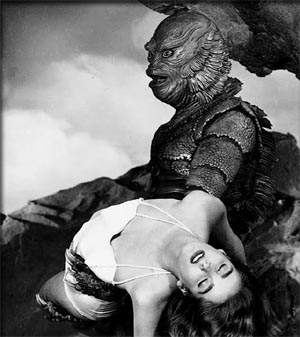
The
creature from the black lagoon had a new girlfriend.
|
Nineteen-fifty-four's,
The Creature from the Black Lagoon, was a late entry
in Universal's horror catalogue and one of the few released
in 3D. Producer William Alland heard the legend of Amazon half-fish,
half-human creatures from Mexican cinematographer Gabriel Figueroa.
Ten years later he hired Maurice Zimm to write a script based
on the idea of an expedition to the Amazon to find one of these
creatures that ends in a monster kidnapping the film's heroine.
The creature, credited to a design by Millicent Patrick, a sculpture
by Chris Mueller, Jr., and make up by Bud Westmore, remains
a classic vision of an aquatic monster.
In addition
to these nine films, Universal produced a large number of sequels
and lessor-known creature features that were additions their
monster universe. Frankenstein alone resulted in The
Bride of Frankenstein, Son of Frankenstein, The Ghost of Frankenstein,
Frankenstein Meets the Wolf Man, and House of Frankenstein.
The
traditional Universal monsters got a new lease on life in the
late 40's when the comic duo of Bud Abbott and Lou Costello
did a comedy entitled Abbott and Costello Meet Frankenstein.
Abbott and Costello had been stars for Universal in the 30's
and early 40's, but by the end of that decade their popularly
was waning. Abbott and Costello Meet Frankenstein (1948),
which also starred Glenn Strange as the monster, Bela Lugosi
as Dracula and Lon Chaney, Jr as the wolf man, was a huge success.
The film revitalized the pair's screen careers and led to other
"monster" pictures including Abbott and Costello Meet the
Killer, Boris Karloff; Abbott and Costello Meet the Invisible
Man; Abbott and Costello Meet Dr. Jekyll and Mr. Hyde
and finally Abbott and Costello Meet the Mummy in 1955.
|
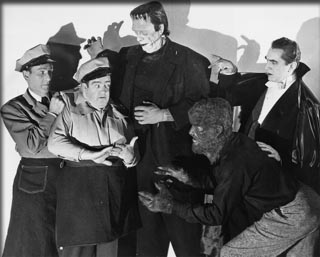
Abbot
and Costello meet Frankenstein (Glenn Strange), Dracula
(Bela Lugosi) and the Wolf Man (Lon Chaney, Jr.).
|
Since
then the studio has only occasionally dipped back into the monster
pool. In 2004 it brought Frankenstein and Dracula together again
in Van Helsing, a film that envisioned Dracula's old
nemesis as an action hero battling supernatural fiends.
Recently,
Universal decided to revive its monster series under the title
Dark Universe. The initial release of the series, The
Mummy, appeared in the summer of 2017 to less than stellar
reviews. Universal will try again in 2019 with a new Bride
of Frankenstein, which is scheduled to be released in February
of 2019.
Perhaps
with this reboot, Universal will be able to recapture some of
its monster magic from the early film era.

Copyright Lee Krystek 2017. All
Rights Reserved.